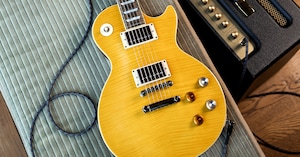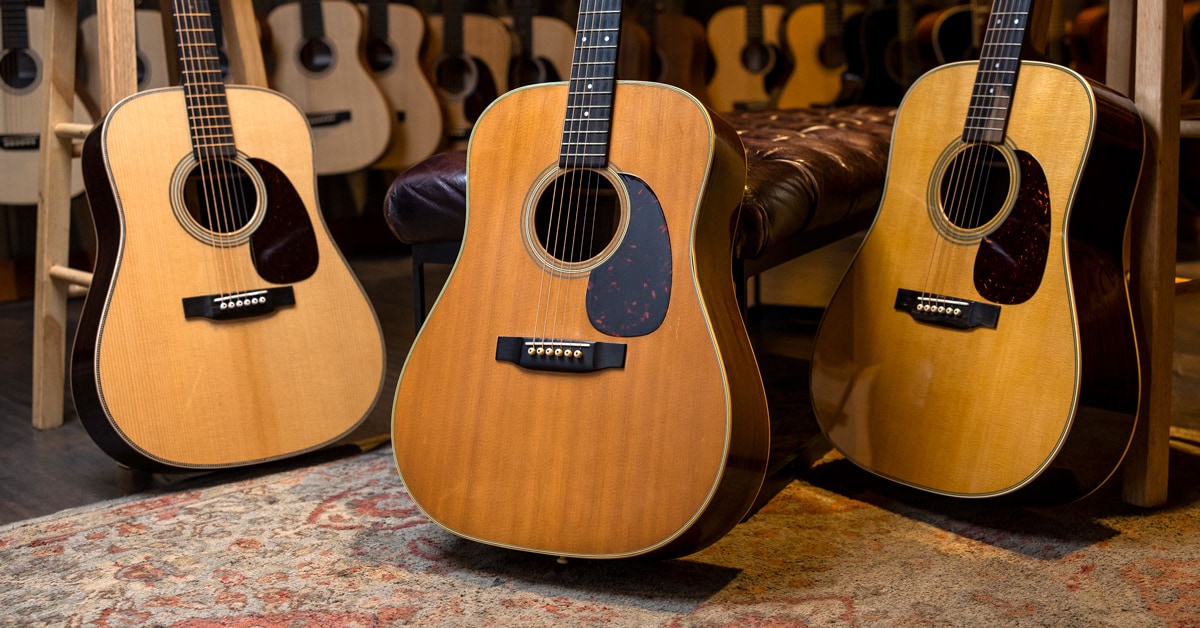What do Noel Gallagher, Hank Williams, Sturgill Simpson, John Frusciante, Bob Dylan, Jimmy Page, Brad Paisley, Father John Misty, Michael Hedges and Joni Mitchell have in common? They all play, or have played, a Martin D-28 acoustic guitar. Since it first appeared in the 1935 C.F. Martin & Company catalog, the big, balanced and articulate sound of the D-28 has made it a consistent top choice for acoustic guitarists across virtually every genre. In this article, we'll take a look at the history and evolution of the guitar, some key moments along the way to the present day and examine a variety of the current models you can find hanging on the wall of Guitar Center's acoustic rooms across the nation.
Table of Contents
The History of the 28 Style Guitar
Birth of the Dreadnought Acoustic Guitar
The Martin D-28
The Early History of the Martin D-28
The Evolution of the Martin D-28
Moments in Martin D-28 History
Famous Martin D-28 Players
Iconic Songs Featuring the Martin D-28
The Beatles—“Blackbird” (1968)
Led Zeppelin—"The Rain Song" (1973)
Bob Dylan—"Tangled Up in Blue" (1975)
Vince Gill—“This Old Guitar and Me” (2003)
Honorable Mentions of Music Featuring the D-28
Martin's Current D-28 Offerings
Martin Standard Series D-28
Martin D-28 Modern Deluxe
Martin HD-28
Martin HD-28E
Martin D-28 Authentic 1937 VTS Top
Martin Billy Strings Signature D-28
Closing the Case for the Martin D-28
The History of the 28 Style Guitar
Though a 0-28 guitar appears in the Martin ledgers as early as 1852, at that time the ledger listings, which predate the first printed catalogs, simply indicated body size and wholesale price (In modern dollars, $28 in 1852 would be equivalent to almost $1,100 today for the wholesale price, so this was not an inexpensive guitar). It wouldn't be for several years yet that the style numbers began to indicate construction and trim details. But by the mid-1870s, Style 28 began its journey toward what we think of today. When it debuted, at a size 0 (sometimes called “concert-size”), the Martin Style 28 was the largest guitar Martin regularly made. There were a handful of 00 size Style 28 guitars built during over the next four decades, but they appear to have all been special orders, not a regular model.
While the iconic "5-9-5" rosette was there on the Style 28 from the beginning, the early guitars tended to be fairly plain, as fancy pearl inlays were kept to the smaller sizes that were mostly seen as "lady's guitars." It wasn't until around the turn of the century that the Style 28 was codified with the rosewood back and sides, spruce top, ebony bridge and fingerboard, bound body and neck, herringbone body trim and "zipper" back strip that we think of today as classic Style 28. At that time, necks were still two-piece Spanish cedar and wouldn't shift to a single piece of mahogany until the 1920s. But the largest body size available was still 00. For the next stage of evolution, we need to step into the world of contract manufacturing.
Birth of the Dreadnought Acoustic Guitar
From its beginnings, C.F. Martin had built guitars for others, either co-branded or without the Martin name, partnering with a number of music retailers on and off over the years. By the early 20th century, these retail partners included music stores like Wurlitzer Music and even mail-order companies like Montgomery Ward. These Martin-built guitars were, inevitably, the highest quality choices available at these outlets, far and away above the quality of the less-expensive guitars turned out by the largely Chicago-based builders who had started up to capitalize on the late 19th-century boom in guitar sales. Oliver Ditson Music, with stores in New York and Boston, was one of those retailers, and it was for them, in 1916, that Martin created the Ditson III model, known as the dreadnought (though for years, Martin would spell it "dreadnaught"), after the giant British battleship, HMS Dreadnought, the largest ever built at that time. The large body delivered the volume and presence guitar players were seeking when playing accompaniment for the then-popular mandolin orchestras. It wouldn't be until 1931 that Martin would make a dreadnought guitar under their own name, and that guitar was the D-28.
The Martin D-28
The Early History of the Martin D-28
In 1931, the Ditson company was sold, and the dreadnought body size, which had been exclusive to them, reverted to C.F. Martin & Company. The dreadnought body created a new, louder, fuller and deeper sound than smaller bodies had, with the superior projection needed to be heard in theaters that were devoted to popular entertainments. However, Martin was still somewhat resistant to building what they considered to be a "bass guitar," feeling that the smaller body sizes had a more balanced tone. There was enough demand for the instrument that they built the guitars but refrained from listing the model in their catalog. The first run of D-28s in 1931, in fact, though they all bore the Martin name and a newly created gold headstock logo decal, was sold exclusively to the Chicago Musical Instrument Company. For the next several years, the D-size body was only sold to a handful of specific dealers and to performing artists who knew what to ask for. It would be 1935 before the D-28 officially appeared in Martin's printed catalog and price list. Ever since that debut, it became and has persisted as one of the top-selling premium acoustic guitars around the world.
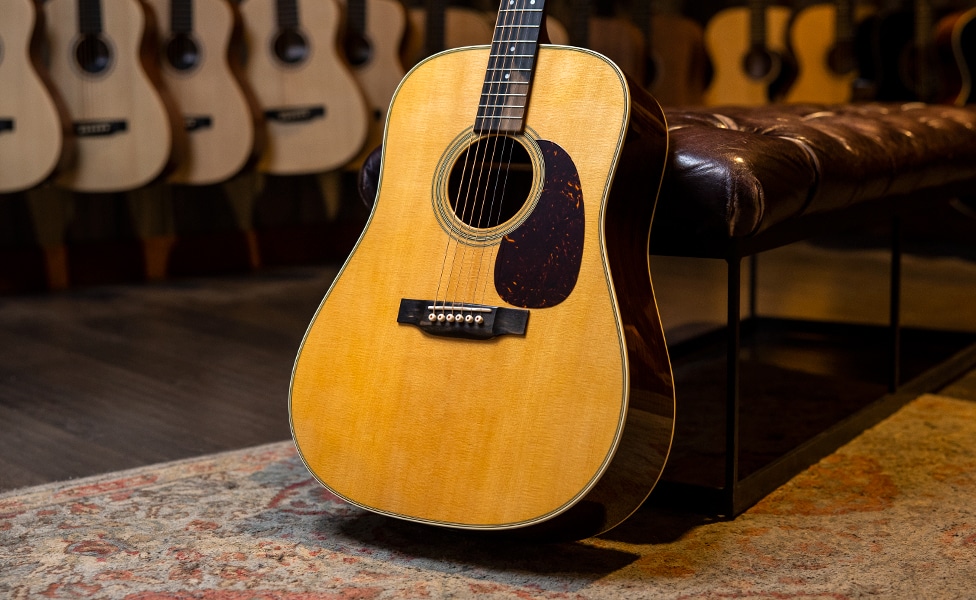
The Martin D-28 has also been one of the most-copied steel-string acoustic guitars ever. Other companies saw the success Martin was having, notably Gibson, who, attempting to go the large dreadnought body one better, introduced the larger, deeper and somewhat louder, round-shouldered Super Jumbo body in 1937. By the 1950s and early 1960s, the folk music boom had companies like Epiphone (the Frontier model) and Guild (the D-40 and D-50, also known as the “Bluegrass Special”) beginning to build dreadnought-style acoustics of their own. But it was the Martin dreadnought that still ruled the roost, thanks to its exceptionally clear articulation and tonal balance.
The Evolution of the Martin D-28
The D-28 has gone through a number of changes in the 90+ years since its debut. Most of these changes have been internal, with a handful of cosmetic ones that have led to a variety of present-day versions of this iconic instrument.
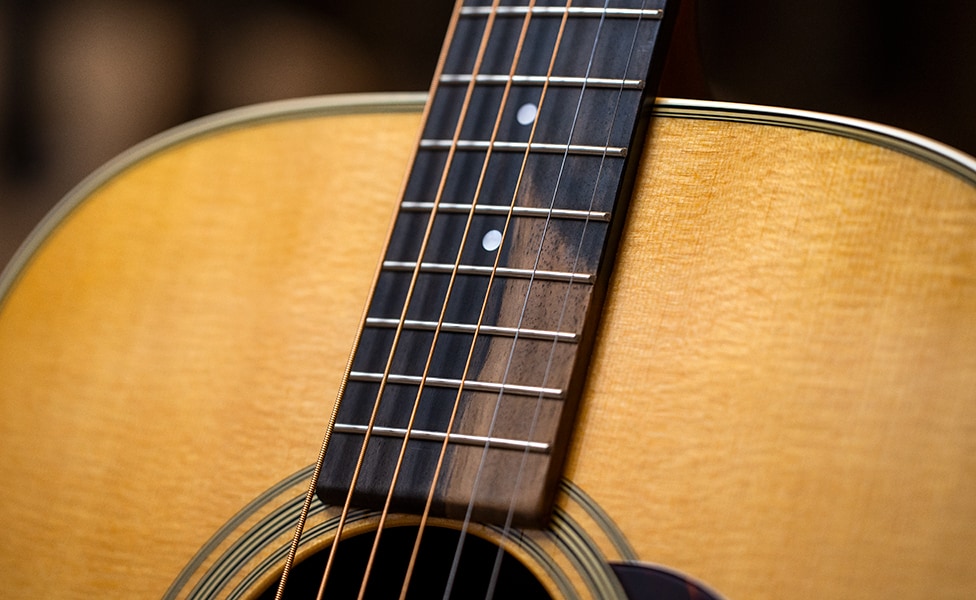
The 14-fret-to-the-body neck was, in the early 1930s, a fairly recent development at Martin. The first couple of years of D-28 production had kept the 12-fret-to-the-neck design. The D-28 was changed to the 14-fret version in 1934, before the guitar had made it into the printed catalog. One of the next changes in the D-28 was the shifting of the scalloped "X" top bracing about 3/4" toward the bridge in 1938. When the guitar was first made, many players used very heavy, .014–.060 strings (including a wound B string), and Martin had an ongoing concern about the stability of the bridge and top with such strings, which was the logic behind shifting where the X brace crossed. Interestingly, in the mid-1960s, about the time that heavy gauge strings were falling out of favor, Martin stiffened the top by switching to a larger and heavier rosewood bridgeplate from the original smaller maple one. The bridgeplate design has shifted back to the smaller maple version, and, on some D-28 versions, even lighter and stiffer carbon graphite.
The top bracing pattern has continued to evolve over time, going from scalloped to straight and then back, when there were indications that the heavier, straight bracing made the guitar top less lively and the response less quick, diminishing the treble response and the articulation on the quick single-note runs for which bluegrass pickers had first adopted the D-28. The recent Vintage, Authentic and Golden Era versions have shifted back to the original forward-shifted position, also called "High X" bracing.
Cosmetically, the biggest change was the shift from the "zipper" herringbone back strip and body trim to a marquetry pattern referred to as "chainlink" in 1946–47. This change was reportedly due to supply issues with the German firm who had been supplying the strips of trim. Martin would later bring back the herringbone trim for the HD-28, the Vintage and Authentic models, and various limited-edition guitars. There was also a shift in fingerboard inlays from the D-28's original diamond and star pattern (Style 28 Long Pattern) to plain dot inlays in 1944.
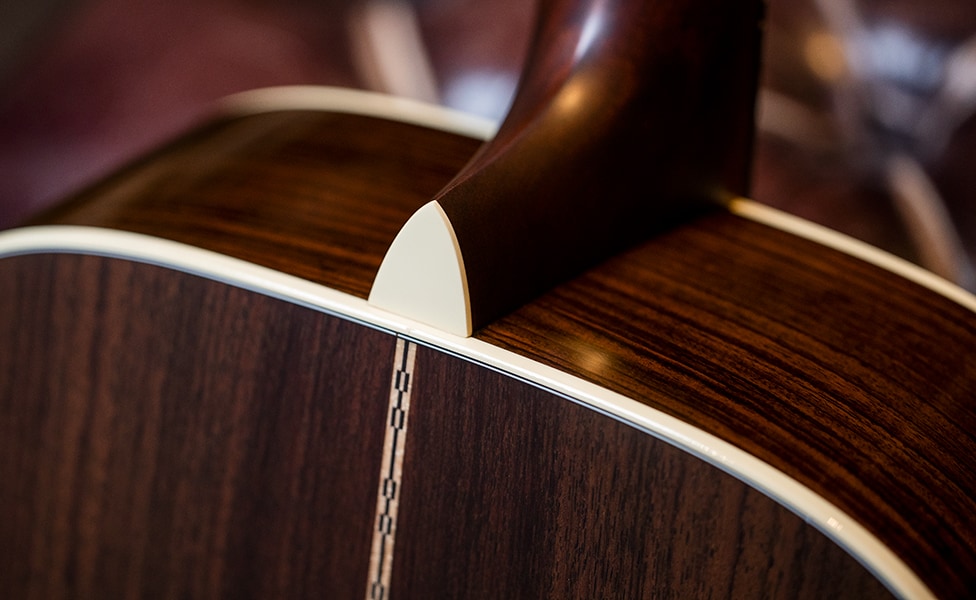
Martin's neck profile started out as a medium V in the 1930s, gradually rounding to more of a D in the 1940s, until the demand for vintage-style neck profiles began to reappear in the 1990s. Because true vintage neck profiles can feel large and clumsy to modern players who frequently switch between electric and acoustic guitars, Martin has developed their Modified Low Oval profile, which maintains some of the feel of a vintage soft-V, but, many players feel, fits the hand better without being too thin. Because the Martin factory had traditionally been hand-profiling necks with a drawknife, there was a great deal of variation from one guitar to the next, until the implementation of CNC (Computerized Numerical Control) milling systems in the '90s brought much more consistency to neck profiles (though Martin still hand finishes the necks after the CNC machines are done).
While the Martin D-28 has never been completely austere, it has never been showy. Its simple but elegant lines and visual style, coupled with its distinct clear, but full-bodied tone, have consistently made it one of the best values in premium acoustic guitars, and has led players across many different genres over the decades to choose it as their primary acoustic guitar, as we shall see.
Moments in Martin D-28 History
Famous Martin D-28 Players
As mentioned in the intro to this piece, the list of well-known players who've used the D-28 over the years is long and varied. It might even be easier to tote up the number of classic acoustic steel-string guitar recordings and performances that didn't use a D-28. Just as a quick example, let's look at Crosby, Stills, Nash & Young. Graham Nash was playing a D-28 with the Hollies, before CSN&Y ever started. Steven Stills and Neil Young are both long-time D-28 devotees, with Young famously owning and playing the D-28 that formerly belonged to country music legend Hank Williams. The late David Crosby is known for bemoaning having traded away a pre-war herringbone D-28 in extremis—and that's just one group. For decades, the D-28 was the default dreadnought guitar, and everybody, from folk musicians to country pickers and rock stars, gravitated to it. In fact, the D-28 was so popular during the 1950s, there was a two-year waiting list to get a new one. For many artists who went on to become superstars, a D-28 was their first really good acoustic before they were known, and they never put it down. John Prine, for example, swore by his vintage D-28 for all his finger picking work. And, although the best-known photograph of Nick Drake is of him holding a small-body Guild M-20 on the cover of his 1971 album, Bryter Layter, the principal steel-string acoustic he was known for playing was a Martin D-28.
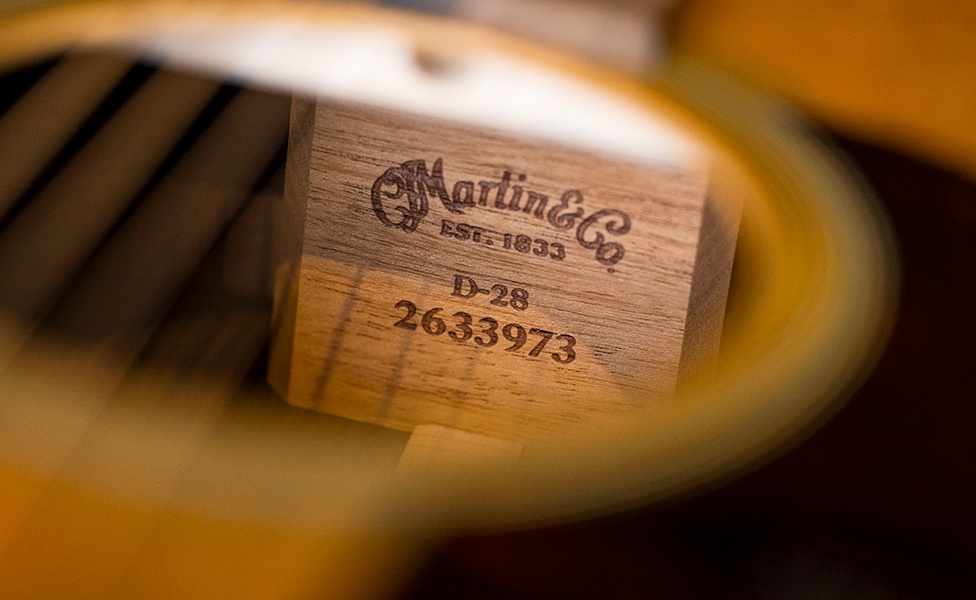
"Wait," you're saying, "what about more modern players?" Noel Gallagher (Oasis and High Flying Birds), James Iha from Smashing Pumpkins, H.E.R., Harry Styles, Sturgill Simpson, Billy Strings, even Jack Black—all are artists who've been seen and heard with their D-28 in hand. And all these artists, classic or new, have put the Martin D-28 to good purpose on record and live.
Iconic Songs Featuring the Martin D-28
There are a lot to choose from, and we’re sure to miss some of your favorites, but here are some highlights from the recorded history of the Martin D-28 acoustic guitar.
The Beatles—"Blackbird" (1968)
Paul McCartney played his D-28 on the folky Beatles classic “Blackbird.” With a catalog as sprawling and spectacular as theirs, “Blackbird” is still often considered one of their most moving and memorable pieces. McCartney also contributed tempo-keeping foot taps to the recording.
Led Zeppelin—"The Rain Song" (1973)
Jimmy Page’s acoustic tracks on “The Rain Song” were recorded with a D-28. A long and winding ballad, Page is believed to have written the song in response to George Harrison’s complaints to John Bonham that Led Zeppelin rarely wrote slow jams. Page has said the song’s first two chords are quoted from the Beatles’ “Something.”
Bob Dylan—"Tangle Up in Blue" (1975)
One of the best-known recordings featuring a D-28 is Bob Dylan’s Blood on the Tracks, on which Dylan barely sets his D-28 down for a moment. “Tangled Up in Blue” is the album’s single and a prime example of a Martin D-28 in the hands of a legendary singer-songwriter.
Vince Gill—"This Old Guitar and Me" (2003)
Vince Gill wrote “This Old Guitar and Me” for his treasured D-28. The song tells the story of purchasing the 1942 model at age 17, traveling the States for years with it by his side and finally retiring the instrument to its case underneath his bed.
Honorable Mentions of Music Featuring the D-28
Looking at more contemporary artists, pretty much anything by Mumford & Sons, like “Little Lion Man,” will feature Marcus Mumford’s D-28. Noel Gallagher picked up a D-28 to use on tour with his High Flying Birds project, and you can catch it in any number of live YouTube videos of “The Death of You and Me,” as well as in his performance of Oasis’ classic “Wonderwall” for Virgin Radio.
A great example of the rich body of a D-28 is also on Colbie Caillat’s “Realize.” There are thousands more out there to track down, and we’ll leave that task to you. Right now, let’s take a look at some of the currently available D-28 variations from C.F. Martin & Company.
Martin's Current D-28 Offerings
C.F. Martin & Company currently builds a number of different D-28 versions, from a standard model to the Vintage and Authentic live versions, plus occasional limited editions featuring unique woods or other special features. You can see all the different versions that are currently available in our Martin D-28 collection, but for this article we're going to focus on the main versions that are currently in production.
Martin Standard Series D-28
Why It’s Cool: For over 90 years, the flagship D-28 has equipped artists in country, folk, rock and beyond with an acoustic instrument that truly sings.
Things to Consider:
- High Performance Taper neck carve aids maneuverability
- Punchy midrange carves through any mix
- Lively, dynamic response is ideal for expressive playing
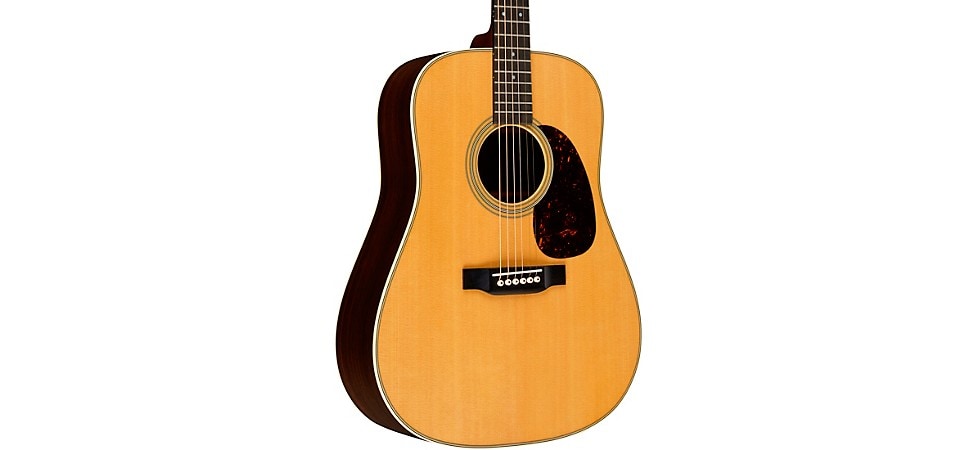
Shop Now: Martin D-28 Standard Dreadnought Acoustic Guitar
The D-28 Standard model is a blend of vintage and modern features. The woods are the classic combination of lively Sitka spruce top, rosewood (East Indian in this case) back and sides and ebony-topped mahogany neck. The top construction brings together the forward-shifted, vintage-style X with non-scalloped braces, for a combination that combines both liveliness and stiffness. The multi-stripe trim and "chainlink" back strip echo the look of the post-WWII D-28s, but the modified oval neck profile gives the instrument a distinctly modern feel.
Martin D-28 Modern Deluxe
Why It’s Cool: The D-28 Modern Deluxe undergoes contemporary treatment methods to capture the experience of playing a treasured vintage acoustic.
Things to Consider:
- Fully matured Martin voice from a modern-built guitar
- Unique appointments include flamed maple binding and gold frets
- Asymmetrical neck profile optimizes comfort up and down the fingerboard
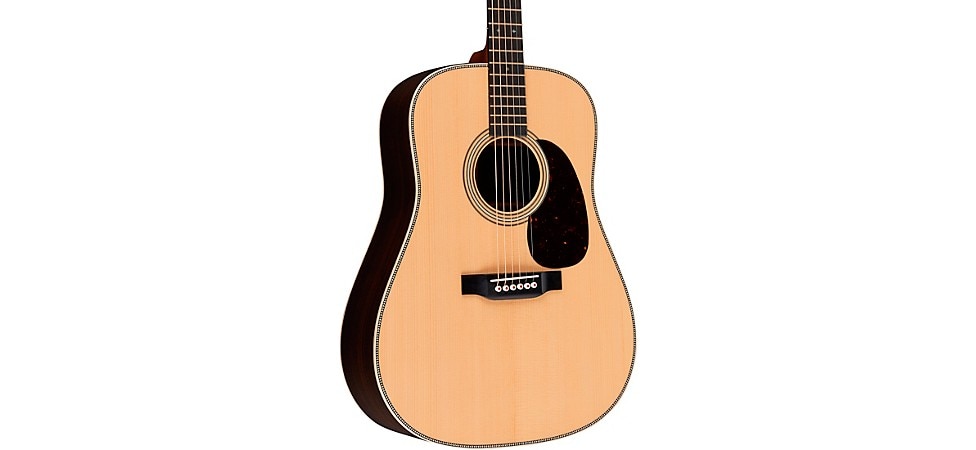
Shop Now: Martin D-28 Modern Deluxe Dreadnought Acoustic Guitar
Martin's Modern Deluxe series is a wonderful combination of vintage and modern guitar building, taking the best from both worlds. The D-28 Modern Deluxe boasts several very special features, beginning with Martin's VTS (Vintage Tone System) top and bracing. VTS uses a carefully applied version of torrefaction (controlled heat treatment in an oxygen-free <anaerobic> environment) to zero in on the aging characteristics of specific vintage guitars in their museum collection. The experts at Martin can pick a guitar, do a deep analysis of the woods and how they've aged, then tailor the VTS process to recreate that aging. This produces a livelier, lighter guitar with the quick response and projection of a vintage piece. It also alters the appearance of the wood in the same way that natural aging does. By combining VTS top and braces, plus using the vintage, forward-shifted bracing pattern, the tone, projection and overall sonic feel are very much that of a treasured vintage piece. The use of Martin's Liquidmetal bridge pins coupled with the graphite bridgeplate adds 2dB of volume to the already outspoken voice of the D-28.
Another nod to the pre-WWII vintage era is in aesthetics, with the return of the classic herringbone body trim and back strip, as well as the vintage diamond and square "long pattern" fingerboard inlays. The use of European flamed maple binding, rather than celluloid or ivoroid plastics, adds a distinctly organic touch to the appearance. Vintage-style open-gear tuning machines keep the classic looks together, but the modern neck profile is smooth, fast and comfortable.
If you're looking for an acoustic-electric, the Martin D-28E Modern Deluxe adds a Fishman Aura VT Blend system with adjustable Aura imaging for maximum flexibility when you plug in.
Martin HD-28
Why It’s Cool: The HD-28 seamlessly combines timeless Martin craftsmanship with the versatility today’s players crave.
Things to Consider:
- Resonant, balanced tone for all styles of music
- High Performance Taper neck plays fast and smooth
- Antique white binding completes a classy look
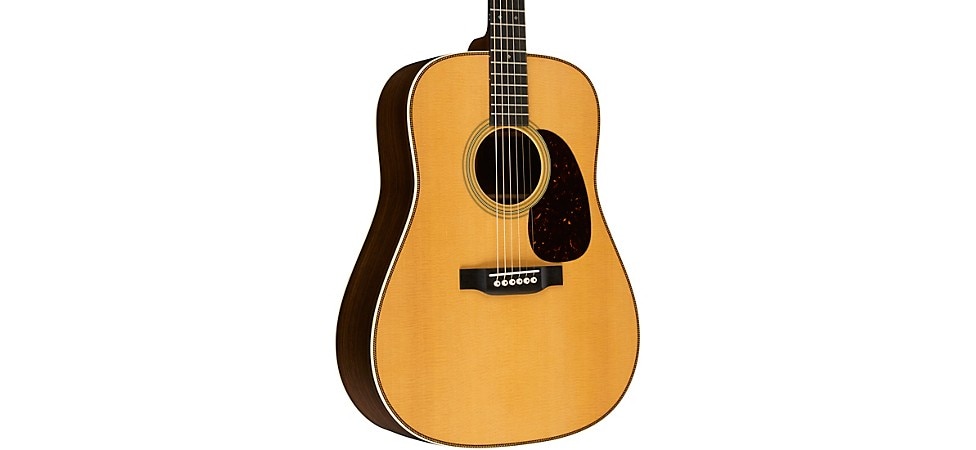
Shop Now: Martin HD-28 Standard Dreadnought Acoustic Guitar
When Martin first created the HD-28 in 1976, it marked the return of vintage looks and construction, with herringbone trim (that's the "H" in "HD") and back strip, plus a tortoiseshell-look pickguard. Scalloped bracing also returned in the HD-28, as many players felt that the lighter weight associated with these braces made for a more responsive top. Over the years since, other vintage features, like the forward-shifted bracing pattern, have returned as well. The HD-28 and the HD-28E acoustic-electric version of the guitar both feature Martin's more modern, Modified Low Oval neck profile, for a feel that's exceedingly comfortable, especially for players who often shift back and forth from acoustic to electric instruments.
Martin HD-28E
Why It’s Cool: Hit the studio or stage with the Martin HD-28E’s organic amplified tones.
Things to Consider:
- Satin neck with High Performance Taper enhances playability
- Golden Era (GE) neck, bracing and bridge design
- Classic big, balanced D-28 tone

Shop Now: Martin HD-28E Standard Dreadnought Acoustic-Electric Guitar
The Martin HD-28E acoustic-electric shares specifications with the regular HD-28 and ups the ante with Fishman Aura VT Enhance electronics to translate its scintillating unplugged voice through onstage amplifiers or in-studio recording devices. As a descendant of coveted, ultrarare D-28 models from the 1930s, the HD-28E incorporates a fast-playing Golden Era Modified Low Oval neck profile; forward-shifted, Golden Era scalloped X-bracing for prominent projection and responsiveness; and a smooth-edged Golden Era Modern Belly bridge style for optimal underhand comfort. If you crave the ability to plug in and get even louder with a D-28’s naturally assertive voice, the Martin HD-28E acoustic-electric guitar ticks all the desirable boxes.
Martin D-28 Authentic 1937 VTS Top
Why It’s Cool: A faithful recreation of a revered vintage acoustic, Martin’s Authentic Series 1937 D-28 pays homage to a mythical production year in the model’s history.
Things to Consider:
- Refined body shape based on 1930s–1940s dreadnoughts
- Sonic profile modeled after museum-grade specimens
- Period-accurate appointments throughout
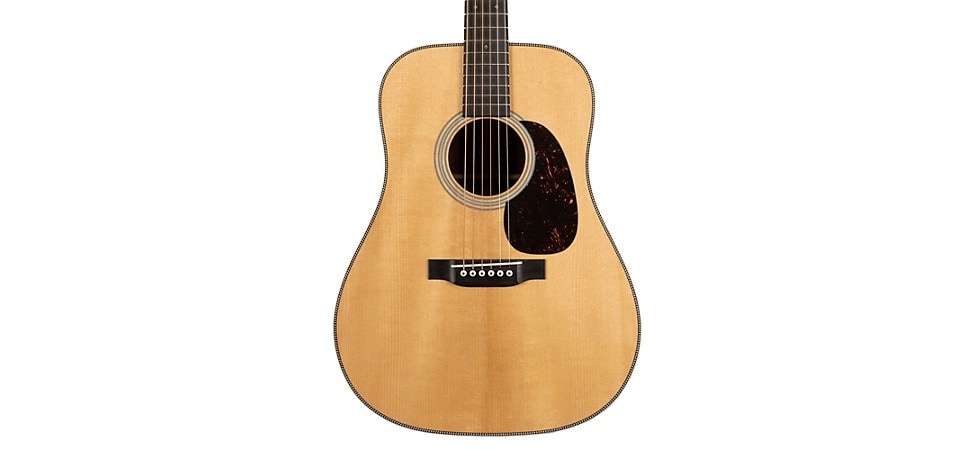
Shop Now: Martin D-28 Authentic 1937 VTS Top Dreadnought Acoustic Guitar
If having a vintage pre-war D-28 is high on your list of dreams, the Martin D-28 Authentic 1937 would pretty much allow you to check that off your list for substantially less than one of the increasingly rare, nearly impossible-to-find original vintage pieces. Thanks to Martin's VTS process (previously discussed) and the museum collection at C.F. Martin & Company, the D-28 Authentic 1937 is, in essence, a clone of one of the finest examples they have. With certified Guatemalan rosewood back and sides; VTS Adirondack spruce top and VTS braces set in the vintage forward-shifted pattern; ebony bridge and fingerboard; and vintage-profile, dovetail-set mahogany neck, the sonic details spring to life. The herringbone purfling and back strip with aged, grained ivoroid binding summon up the classic mid-'30s vibe. Traditional materials, like the bone for the nut and saddle, and hide glue, make the D-28 Authentic almost a time capsule. This is a once-in-a-lifetime guitar for true aficionados of quality acoustic instruments.
Martin Billy Strings Signature D-28
Why It’s Cool: Taking inspiration from his classic 1940 D-28, the Billy Strings signature version features custom specs tailored to his intricate, expressive playing style.
Things to Consider:
- Shorter 25" scale length
- Slightly slimmer nut width (1-23/32")
- Exclusive closed-gear nickel tuners

Shop Now: Martin Billy Strings Signature D-28 Acoustic Guitar
Billy Strings—the Grammy Award-winning, modern bluegrass guitar hero—is a master of rapid-fire flatpicking, and his signature Martin D-28 lends itself to his virtuosic musical excursions. One of this guitar’s defining features is its unique 25" scale length that reduces string tension, allowing easier bends and faster finger movement when only a light touch is required. The 1-23/32" nut width is also wider than the one found on Strings’ prized 1940 model but moderately slimmer than the average 1-3/4" Martin measurement—shaving a hair off makes it that much easier to fly across the fretboard in true rock star fashion.
Closing the Case for the Martin D-28
The D-28 has always been one of those guitars that just seems to be there at critical moments in music history. Its relatively unadorned looks and unsurpassed tone and clarity have made it very much the touchstone in acoustic guitar music. For so many legends, the D-28 was the guitar that became a part of them. Sonically and aesthetically, the D-28 defined what a dreadnought guitar should be, and its spirit lives in every acoustic guitar model that that starts with a "D."
If this article has you closing your eyes and dreaming, rest assured that Guitar Center has the D-28 that's in those dreams, whether it's a custom order from C.F. Martin & Company, a new version that's already hanging on the wall in one of our stores, or in our huge Used & Vintage collections. Just come in and talk to one of our associates at your local Guitar Center store or dial up our Contact Center to speak with a Gear Adviser, and we'll help you track down the one that fits you like a glove.
If you're curious about Martin's current standard series offerings, check out A Guide to Martin's Standard Series Acoustic Guitars.


